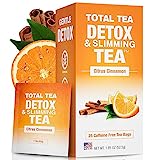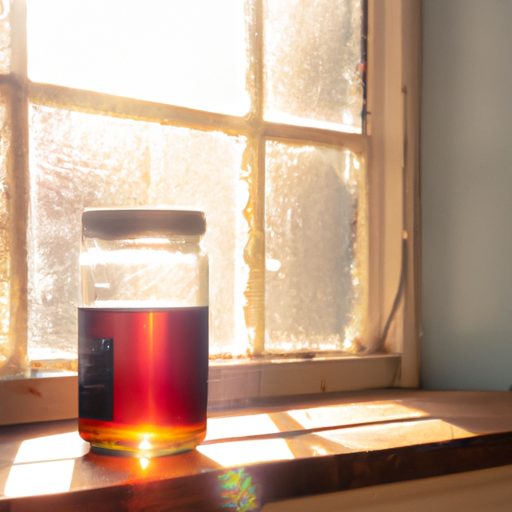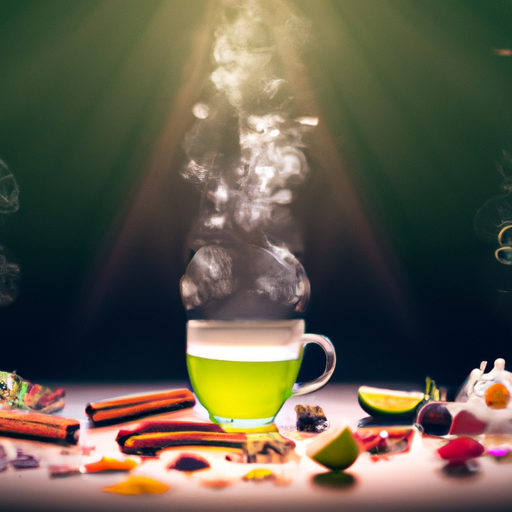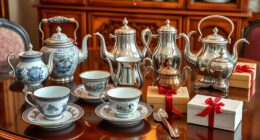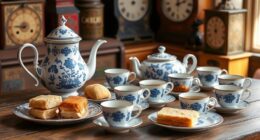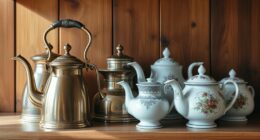For centuries, herbal tea has been appreciated for its medicinal properties and soothing effects.
In fact, studies show that herbal tea consumption has been on the rise, with over 158 million Americans drinking it on a regular basis.
If you’re a fan of herbal tea and want to take your passion to the next level, why not try drying your own herbs to create your very own homemade blends?
Not only is it a fun and satisfying process, but it also allows you to have complete control over the quality and flavors of your tea.
In this article, I will guide you through the steps of drying herbal tea, from choosing the right herbs to storing and preserving them.
Get ready to embark on a journey of aromatic herbs and delightful flavors that will elevate your tea-drinking experience to new heights!
Key Takeaways
- Herbal tea can be easily dried at home using different methods such as air drying, oven drying, or using a dehydrator.
- It is important to harvest herbs at their peak flavor and aroma, ideally in the morning after the dew has dried but before the sun is at its peak.
- Proper storage of dried herbal tea is essential to preserve freshness and flavor, including using airtight containers, storing in a cool, dark, and dry place, and labeling each container with the name and date.
- Dried herbs can be used not only for brewing herbal tea but also for enhancing flavors in cooking, offering a creative culinary experience.
Choosing the Right Herbs for Drying
Now, let’s dive into choosing the perfect herbs for drying so you can savor the delightful flavors in your homemade herbal tea! When it comes to growing herbs for drying, it’s important to consider the benefits of herbal tea.
Not only does it offer a refreshing and soothing experience, but it also provides numerous health benefits. Some popular herbs for drying include chamomile, lavender, peppermint, and lemon balm.
Chamomile is known for its calming properties, lavender adds a floral touch, peppermint offers a refreshing taste, and lemon balm provides a citrusy twist. These herbs can be easily grown in your garden or even in pots indoors.
Make sure to harvest them when they are at their peak flavor and aroma. By choosing the right herbs, you can create a delicious and beneficial herbal tea that will enhance your well-being.
Harvesting and Preparing the Herbs
First, make sure you’ve harvested and prepared your herbs properly for the best flavor in your homemade infusion. When it comes to drying herbal tea, the quality of the herbs is crucial.
Here are some key steps to follow:
-
Choose herbs that’ve been grown in optimal conditions. They should be free from pesticides and chemical fertilizers.
-
Harvest the herbs at the right time. The best harvesting time varies depending on the herb. Generally, it’s recommended to pick them in the morning after the dew has dried but before the sun’s at its peak.
-
Cut the herbs using clean, sharp scissors or pruning shears. Remove any damaged or discolored parts.
-
Wash the herbs gently to remove any dirt or insects. Pat them dry with a clean towel.
By following these steps, you can ensure that your herbs are of the highest quality and will result in a flavorful and aromatic herbal tea.
Air Drying Method
To air dry your herbs, you’ll need to hang them in a well-ventilated area for about two weeks. This allows them to retain their flavors and aromas while reducing moisture content by up to 70%. This method is an excellent way of preserving the flavors of your herbs without needing any special equipment.
Start by harvesting your herbs in the morning when their essential oils are at their peak. Gently shake off any excess dirt or insects, and remove any damaged or discolored leaves. Bundle small bunches of herbs together with twine or rubber bands, making sure they aren’t too tightly packed.
Hang the bundles upside down in a cool, dry place away from direct sunlight. After two weeks, your herbs should be completely dry and ready to be stored in airtight containers. Remember to label them properly for easy identification.
Enjoy the rich flavors of your homemade dried herbal tea!
Oven Drying Method
If you’re looking for a quicker way to preserve your herbs, try the oven drying method – it’s a game changer! This method is perfect for when you need your herbal tea fix in a hurry.
To start, preheat your oven to a low temperature, around 100 degrees Fahrenheit. While the oven is heating up, prepare your herbs by washing and patting them dry with a paper towel. Then, remove any excess stems and lay the herbs in a single layer on a baking sheet lined with parchment paper.
Place the baking sheet in the oven and let the herbs dry for about 2-4 hours, or until they are crispy to the touch. Keep an eye on them to prevent any burning. Once they’re dry, remove from the oven and let them cool completely before storing in an airtight container.
Using a Dehydrator
Using a dehydrator is like taking your herbs on a journey through a time machine, transforming them into perfectly preserved pockets of flavor. When it comes to drying herbal tea, using a dehydrator offers many benefits.
First, dehydrators are designed specifically for drying foods, so you can trust that your herbs will be dried evenly and thoroughly. Second, using a dehydrator allows you to maintain the maximum amount of flavor and aroma in your herbs, as they dry at a low temperature over a longer period of time.
Plus, dehydrators are easy to maintain. Simply clean the trays and filters regularly, and your dehydrator will continue to work efficiently. So, if you want to enjoy the full benefits of drying herbal tea, using a dehydrator is definitely the way to go.
Storing and Preserving Dried Herbal Tea
One way to ensure the longevity and freshness of your dried herbal tea is by storing it in airtight containers or glass jars. This helps to preserve the tea’s freshness and prevent it from losing its flavor and aroma over time.
Here are three key tips for storing and preserving dried herbal tea:
- Keep the containers in a cool, dark, and dry place to avoid exposure to light, heat, and moisture.
- Label each container with the name of the tea and the date it was dried to easily identify and rotate your stash.
- Avoid opening the containers too frequently as air and moisture can degrade the quality of the tea.
By following these guidelines, you can extend the shelf life of your dried herbal tea and continue to enjoy its delightful flavors and therapeutic benefits for months to come.
Brewing and Enjoying Your Homemade Herbal Tea
To truly savor the rich flavors and soothing qualities of your homemade herbal tea, it’s important to brew it with care and take a moment to fully enjoy each sip.
Brewing your herbal tea is simple and can be done in a few easy steps. Start by boiling water and pouring it over your desired amount of dried herbs. Let it steep for about 5-10 minutes, or longer if you prefer a stronger flavor. Strain the herbs and pour the tea into your favorite mug.
Now, sit back, relax, and reap the health benefits of your homemade herbal tea. Not only does it provide a comforting and delicious drink, but herbal tea also offers various health benefits, such as boosting the immune system, aiding digestion, and promoting relaxation.
Additionally, dried herbs can be used creatively in cooking to enhance the flavors of your favorite dishes. So, don’t limit yourself to just drinking herbal tea – explore different ways to incorporate dried herbs in your culinary adventures.
Frequently Asked Questions
How long does it take to dry herbal tea using the air drying method?
It typically takes about 1-2 weeks to air dry herbal tea. Once dried, store it in an airtight container in a cool, dark place to maintain its flavor and potency. Other drying methods include oven drying and using a dehydrator.
Can I use any type of oven for drying herbal tea?
Yes, you can use any type of oven for drying herbal tea. Using different types of herbs for drying tea allows for a variety of flavors. Additionally, a dehydrator can also be used for drying herbal tea.
Is it necessary to wash the herbs before drying them?
It is necessary to wash herbs before drying them. Washing removes dirt, pesticides, and any other impurities that may be present. This ensures that the dried herbal tea is clean and safe to consume.
Can I mix different types of herbs together when drying them?
Yes, you can mix different types of herbs together when drying them for herbal tea. There are various methods for drying herbs, such as air drying, dehydrating, or using an oven. Each method preserves the flavors and aromas of the herbs effectively.
Can I use dried herbs for making other types of tea, like iced tea or herbal blends?
Yes, dried herbs can be used for making other types of tea, such as iced tea or herbal blends. They can also be used for medicinal purposes, as they retain their beneficial properties when dried.
Conclusion
In conclusion, drying herbal tea is a simple and rewarding process that allows you to enjoy the benefits of your favorite herbs all year round. By carefully selecting and harvesting your herbs, and using one of the three drying methods – air drying, oven drying, or using a dehydrator – you can preserve their flavors and medicinal properties.
Properly storing your dried herbal tea ensures its freshness for a long time. So go ahead and indulge in the pleasure of brewing and savoring your homemade herbal tea, knowing that you have expertly preserved its essence.


